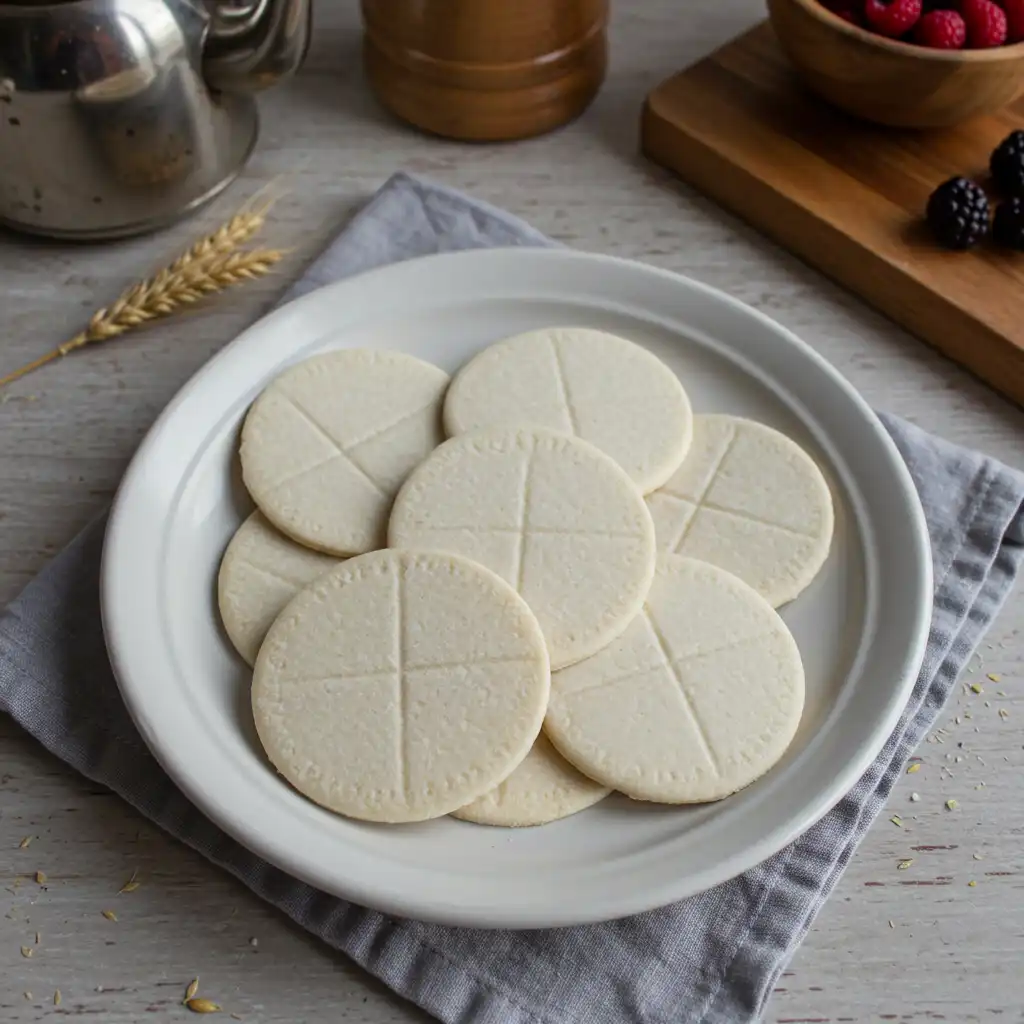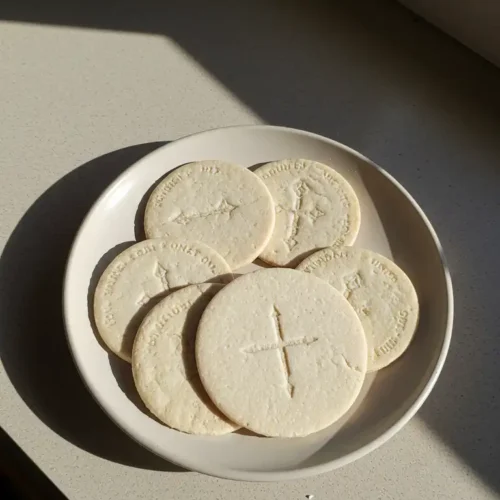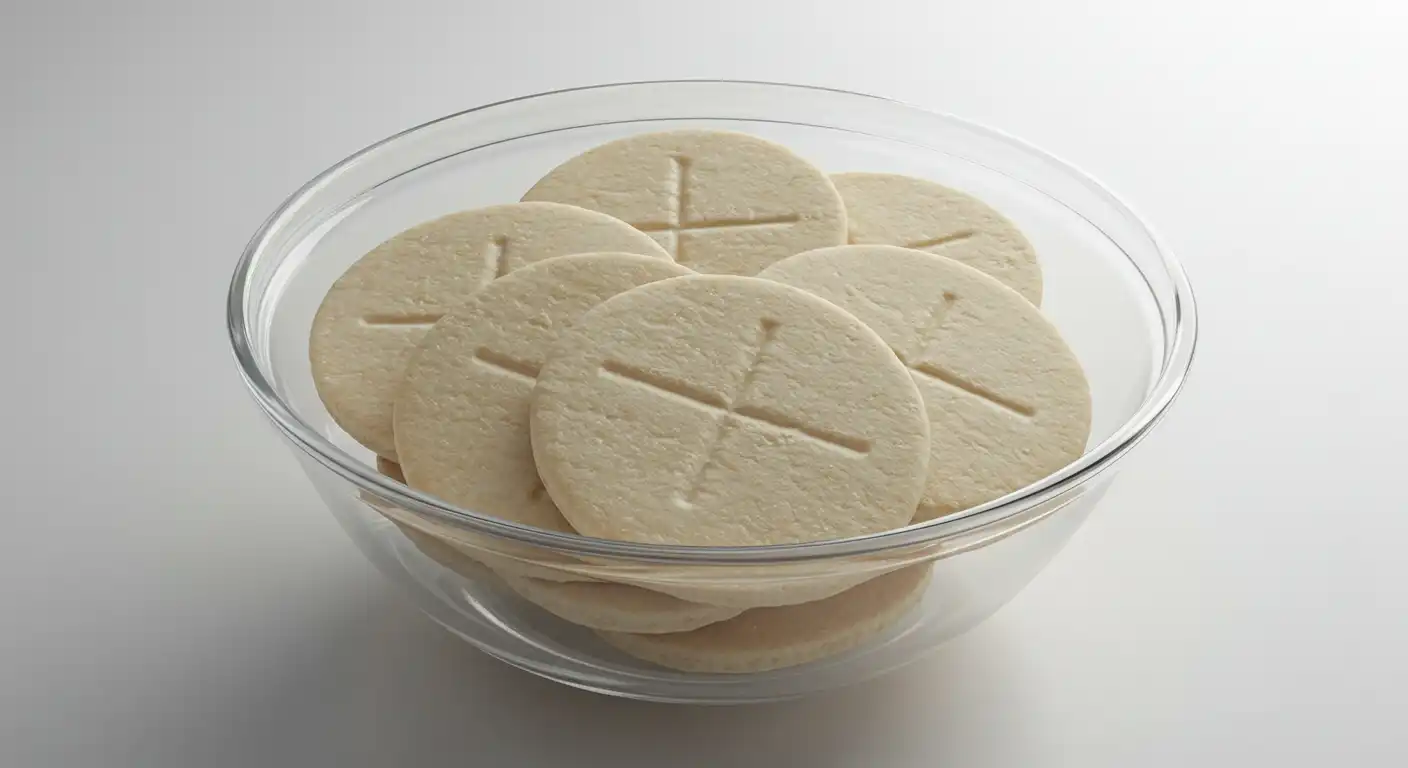Introduction
When I first encountered the need for gluten free communion wafers, it was during a service at my local church. A close friend with celiac disease felt uneasy about partaking in communion because traditional wafers contain gluten, potentially causing severe health risks. In that moment, I realized just how important it is for congregations to provide accessible and safe options for everyone, ensuring that no one is left out of this sacred rite.
Over the years, more churches have begun offering gluten free communion wafers to support the growing number of people with celiac disease or gluten sensitivities. Not only does this promote a greater sense of inclusion, but it also underscores our collective responsibility to create worship experiences that accommodate all members. Fortunately, high-quality alternatives exist, and some can even be made at home using simple, trusted ingredients.
In this guide, I’ll walk you through everything you need to know about choosing, preparing, and serving gluten free communion wafers. From discussing top-rated brands to sharing tips for ensuring proper storage and preventing cross-contamination, this resource aims to make the sacrament more inclusive for everyone. By the end, you’ll feel confident in selecting or making wafers that honor both faith traditions and necessary dietary restrictions.
Why Gluten-Free Communion Wafers?

Offering gluten free communion wafers in a church setting is more than just a dietary adjustment; it’s a meaningful gesture of inclusivity and unity. Traditionally, wheat-based wafers have been used for communion, but these can pose serious health risks to individuals with celiac disease or gluten intolerance. By providing a safe, gluten-free alternative, congregations ensure that everyone, regardless of dietary needs, can participate fully in one of the most sacred elements of worship.
Addressing Celiac Disease and Gluten Intolerance
For individuals with celiac disease or gluten sensitivities, even trace amounts of gluten can result in painful symptoms or long-term complications. In my experience, this challenge can create a sense of exclusion, especially in religious settings where participation in communion is both spiritually significant and communal. Gluten-free wafers remove this barrier, affirming that every person has a rightful place at the table without risking their health.
Upholding Inclusion and Accessibility
Communion symbolizes unity, fellowship, and shared faith. When certain members of the congregation cannot safely partake, it undermines the very essence of this sacred practice. By offering gluten free communion wafers, churches can uphold the principles of hospitality and inclusivity. This shift not only acknowledges individual needs but also reinforces the message that everyone is welcome and valued in the worship experience.
Preserving the Symbolic Significance
Some might worry that altering the traditional wafer recipe changes the sacramental meaning. However, the core symbolism of communion remains intact commemorating the Last Supper and embracing spiritual fellowship. Gluten-free communion wafers simply adapt the recipe, not the rite itself, ensuring that all congregants can engage in the Eucharist. In fact, many find that adopting accessible elements enhances the spirit of compassion and unity inherent in the sacrament.
By choosing gluten free communion wafers, faith communities demonstrate a commitment to caring for all members and reflect a growing understanding of health and wellness. This inclusive approach reminds us that the heart of communion is about coming together as one, celebrating faith without leaving anyone behind.
Sourcing Quality Gluten Free Communion Wafers
Once you understand why gluten-free options are essential, the next step is finding the right gluten free communion wafers for your congregation or personal use. While quality and safety should always be top priorities, there are several practical factors to consider when deciding which wafers to buy or recommend.
Certified Brands and Labeling
Not all wafers labeled “gluten free” are created equal. Look for certifications from reputable organizations such as the Gluten-Free Certification Organization (GFCO), which ensures products meet stringent standards for gluten content (often less than 10 parts per million). Reading labels carefully is vital keep an eye out for any disclaimers about shared facilities or potential cross-contamination.
Pro Tip: If a product claims to be gluten-free but is processed on equipment that also handles wheat, it may not be suitable for individuals with celiac disease. Always check the packaging or company website for detailed production information.
Ingredients and Allergen Considerations
In my experience, the most common ingredients in gluten free communion wafers are rice flour, potato starch, or other non-wheat flours. Some brands may add small amounts of oils or flavoring agents to improve taste and texture. If your community also navigates sugar sensitivity, check out our Sugar-Free Granola recipe for a wholesome, allergen-conscious snack option. Make sure to verify that these wafers don’t include other major allergens (like soy or dairy) if you need to accommodate multiple dietary requirements in your congregation.
Helpful Insight: Brands that specialize in allergy-friendly products often use dedicated gluten-free facilities, which further reduces cross-contamination risks.
Cost and Accessibility
The price of gluten-free products can be higher than standard wafers due to specialized production methods and quality testing. Compare prices among different suppliers to find a balance between cost and quality. It may be more economical to buy larger quantities if you’ll use them regularly, especially if your church holds multiple services each week.
Where to Buy
- Local Christian Bookstores: Some stock gluten free communion wafers alongside other liturgical supplies.
- Online Retailers: Websites dedicated to religious supplies or gluten-free products often offer discounts for bulk orders.
- Direct from Manufacturers: Buying in larger batches directly from the brand can sometimes reduce overall costs.
By taking the time to research certified brands, read labels thoroughly, and weigh the cost implications, you’ll ensure that your chosen gluten free communion wafers meet high standards for both safety and quality.
Making Your Own Gluten Free Communion Wafers
While many people choose to purchase gluten free communion wafers from certified brands, there’s something special about crafting your own for a truly personalized touch. In my experience, homemade wafers offer both flexibility and reassurance you control every ingredient and step in the process, ensuring they meet your specific dietary and taste preferences. Below are some key considerations and tips to help you achieve a successful batch from the comfort of your own kitchen.
Essential Ingredients and Tools
The foundation of gluten free communion wafers typically involves a blend of gluten-free flours, water, and a small amount of salt. Popular flour options include rice flour, potato starch, or tapioca flour, all of which create a texture similar to traditional wheat wafers.
- Gluten-Free Flour: Choose a certified blend without any added leavening agents.
- Salt: A pinch to enhance flavor (optional, based on your congregation’s preferences).
- Water: Adjust the amount to achieve a dough that’s firm yet pliable.
- Basic Tools: Rolling pin, mixing bowl, parchment paper, and a baking sheet.
Pro Tip: Keep an eye on ingredient labels and buy from reputable sources to avoid cross-contamination. If you or someone in your congregation has additional allergies (e.g., soy or dairy), verify that the chosen flour blend is free from those allergens as well.
Basic Preparation Steps
- Mix the Dry Ingredients
Combine the gluten-free flour blend and salt in a mixing bowl, ensuring even distribution before adding liquid. - Gradually Add Water
Slowly pour in room-temperature water while stirring. The goal is a smooth, pliable dough that’s not too sticky or crumbly. - Roll and Cut
Place the dough between two sheets of parchment paper to prevent sticking. Roll it out to about 1/8-inch thickness, then use a circular cookie cutter (or a small lid) to create uniform wafer shapes. - Bake Until Crisp
Transfer the cut wafers onto a parchment-lined baking sheet. Bake at around 350°F (175°C) for approximately 8–10 minutes, or until they appear dry and slightly golden around the edges.
Helpful Tip: If your wafers tend to crack or break, add a small amount of oil (e.g., vegetable oil) to the dough for extra pliability. Alternatively, lightly spritz the top of the dough with water if it seems too dry.
Flavor and Texture Customizations
- Substitute Different Flours: Experiment with blends like sorghum or chickpea flour for a heartier flavor.
- Seasoning Options: While communion wafers are traditionally neutral, a minimal amount of herbs or even a tiny bit of sweetener can alter the taste if desired by your congregation. If you’re exploring naturally sweetened baked goods, you may enjoy experimenting with Low Sugar Blueberry Protein Muffins as part of your test kitchen journey.
By making your own gluten free communion wafers, you gain full control over every aspect of the process from the choice of ingredients to the final consistency. This hands-on approach can be a meaningful experience for individuals, families, or small worship groups seeking to deepen their connection to the Eucharist through a truly personalized element of worship.
Serving Gluten Free Communion Wafers in Worship
Implementing gluten free communion wafers into your congregation’s practices requires more than just buying or baking them. Proper serving methods help preserve the sanctity of communion and protect congregants from accidental gluten exposure. In my experience, a few simple guidelines can make the transition seamless, ensuring a welcoming environment for all.
Preventing Cross-Contamination
- Separate Containers: Keep gluten-free wafers in a clearly labeled, dedicated container or pyx, separate from regular wheat-based wafers.
- Dedicated Utensils: Use unique serving plates or cups for the gluten-free elements. This method of thoughtful separation is also great when serving recipes like our Cheesy Garlic Chicken Wraps during potlucks or church gatherings to accommodate mixed dietary needs. This step helps avoid tiny crumbs or particles mixing with traditional wafers.
- Sanitized Hands: If a priest or minister distributes both wafer types, ensure they thoroughly wash or sanitize their hands between servings to prevent cross-contact.
Pro Tip: Communicate these measures to both clergy and volunteers so that everyone follows consistent, safe handling practices.
Communicating Inclusivity
- Announcements and Signage: Before the service, let attendees know that gluten free communion wafers are available. This simple act can alleviate anxiety for those concerned about their health.
- Order of Service Notes: Include a brief mention in the church bulletin or projected slides, directing congregants to where they can receive GF wafers.
- Ushers and Greeters: Train ushers to guide anyone with dietary needs to the appropriate line or station, ensuring an inclusive worship experience.
Real-Life Insight: In congregations where gluten free wafers are a regular offering, I’ve found that a short announcement at the beginning of communion reminding everyone that there is a gluten-free option makes visitors and new attendees feel welcomed.
Emphasizing Unity and Reverence
Despite the practical changes, the act of communion remains deeply spiritual. Highlight that using gluten free wafers in no way diminishes the sacrament’s significance; it simply broadens accessibility. Many communities embrace this adaptation as a reflection of their commitment to inclusivity and compassion, core principles of Christian fellowship.
By taking these steps avoiding cross-contamination, openly communicating the availability of gluten free communion wafers, and maintaining a thoughtful, reverent tone your church can uphold the sacred nature of communion while ensuring every congregant has the chance to participate safely.

Gluten-Free Communion Wafers
Equipment
- Rolling Pin
- Mixing Bowl
- Parchment Paper
- Baking Sheet
- Cookie Cutter (small round)
Ingredients
Wafer Dough
- 1 cup gluten-free flour blend certified gluten-free, no leavening agents
- 1/4 tsp salt optional
- 1/3 cup water room temperature, adjust as needed
- 1 tsp vegetable oil optional, for pliability
Instructions
- Preheat oven to 350°F (175°C). Line a baking sheet with parchment paper.
- In a bowl, combine the gluten-free flour and salt (if using).
- Gradually add water, mixing until a firm but pliable dough forms. Add oil if needed.
- Place dough between two sheets of parchment paper and roll to 1/8-inch thickness.
- Cut into small circles using a cookie cutter. Transfer to the baking sheet.
- Bake for 8–10 minutes until dry and slightly golden. Let cool before serving.
Notes
FAQs
How Long Do Gluten Free Wafers Stay Fresh?
Like any baked product, gluten free communion wafers can lose their crispness or even turn stale over time. In my experience, storing them in an airtight container keeps them fresh for up to two weeks. For long-term storage, you can freeze them just be sure to let them return to room temperature before serving.
Tip: Label containers with the date they were made or purchased to track freshness accurately.
What If My Homemade Wafers Crack or Crumble?
Homemade gluten free dough can be temperamental:
Add a Little Oil: A small amount of oil (like olive or vegetable) can help bind the dough and reduce cracking.
Monitor Moisture: If the dough is too dry, lightly mist it with water or add more liquid, one tablespoon at a time.
Roll Evenly: Uneven thickness leads to uneven baking and can cause brittleness.
Can a Congregation Use Low-Gluten Hosts Instead?
Many churches offer low-gluten hosts for individuals who can tolerate trace amounts of gluten. However, those with severe celiac disease generally need fully gluten-free wafers to avoid potential flare-ups. Check with your congregation’s needs and any official liturgical guidelines before opting for low-gluten over entirely gluten free.
Addressing Taste and Texture Concerns
Some gluten free wafers can have a slightly different flavor or mouthfeel:
Try Different Flour Blends: Rice flour creates a lighter wafer, while sorghum flour can produce a denser, heartier bite. We found similar results in testing textures for baked recipes like this Banana Bread Mix, which balances softness and structure beautifully.
Experiment with Baking Time: Adjusting the bake time by a minute or two can help achieve the desired crispness.
Further Resources for Support
Church Bulletins and Communication: Outline your gluten-free practices so everyone knows what to expect.
Local Celiac Groups: Seek advice from local organizations that offer tips on sourcing or baking safe gluten free products. And for more scratch-made inspiration, try these Sourdough Discard Cinnamon Rolls made with a gluten-conscious approach.
Official Church Guidelines: Some denominations have specific rules on communion elements. Confirm these to ensure compliance.
Conclusion
From sourcing certified brands to crafting your own recipe at home, the journey toward offering gluten free communion wafers involves attention to detail and a commitment to inclusivity. For individuals with celiac disease or gluten sensitivities, these wafers can transform the communion experience from one of apprehension to one of welcome participation. And for churches, embracing gluten-free options underscores a broader principle of hospitality everyone deserves a place at the table.
In my experience, thoughtful planning is the key to a smooth transition. Simple steps like storing wafers separately, clearly labeling them, and communicating their availability can make all the difference. By prioritizing safety, taste, and symbolic reverence, congregations can ensure the sacred nature of communion remains intact while honoring the health needs of every member. Ultimately, gluten free communion wafers serve as a tangible reminder of unity, compassion, and shared faith allowing all worshippers to partake in this profound rite with confidence and peace of mind.
